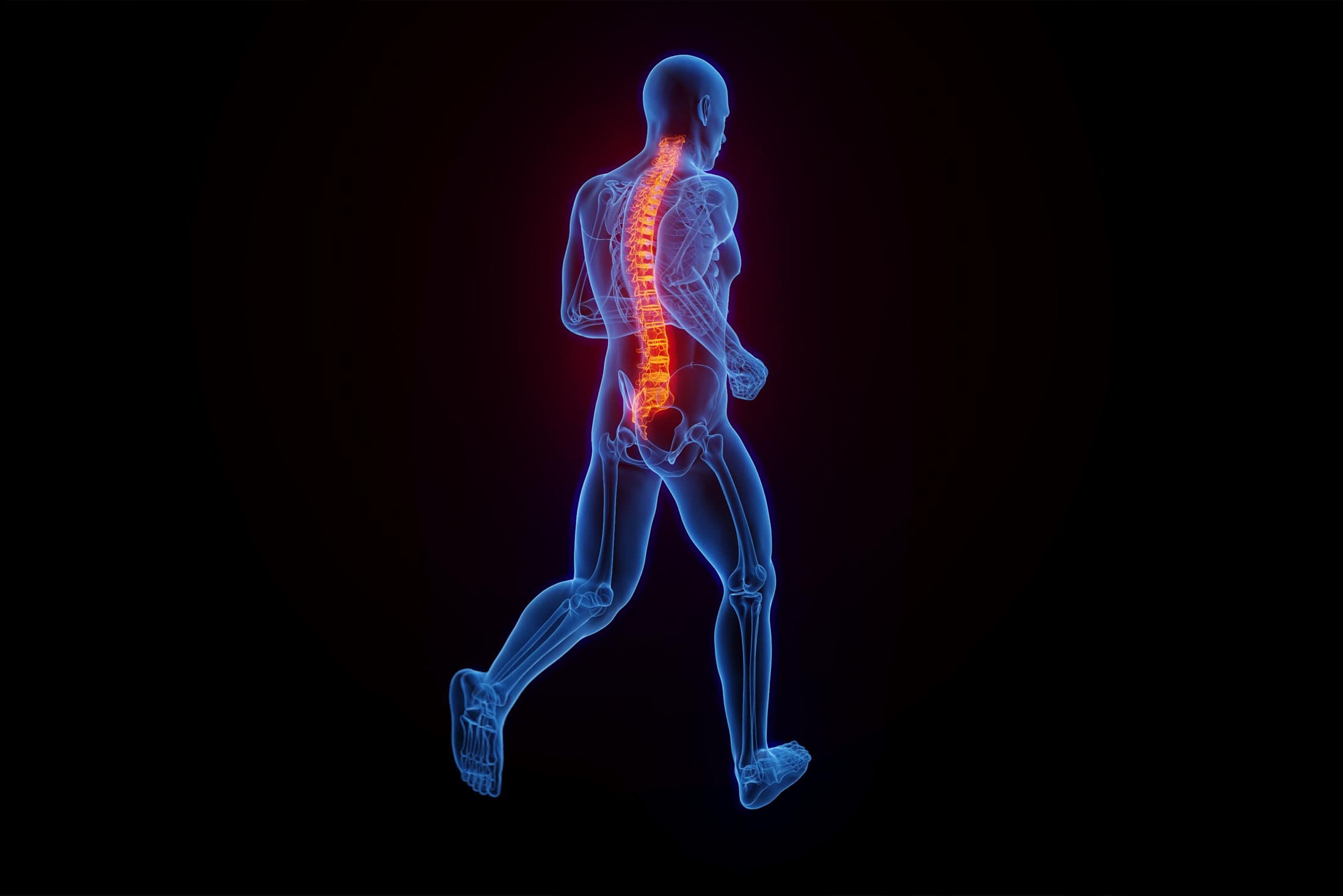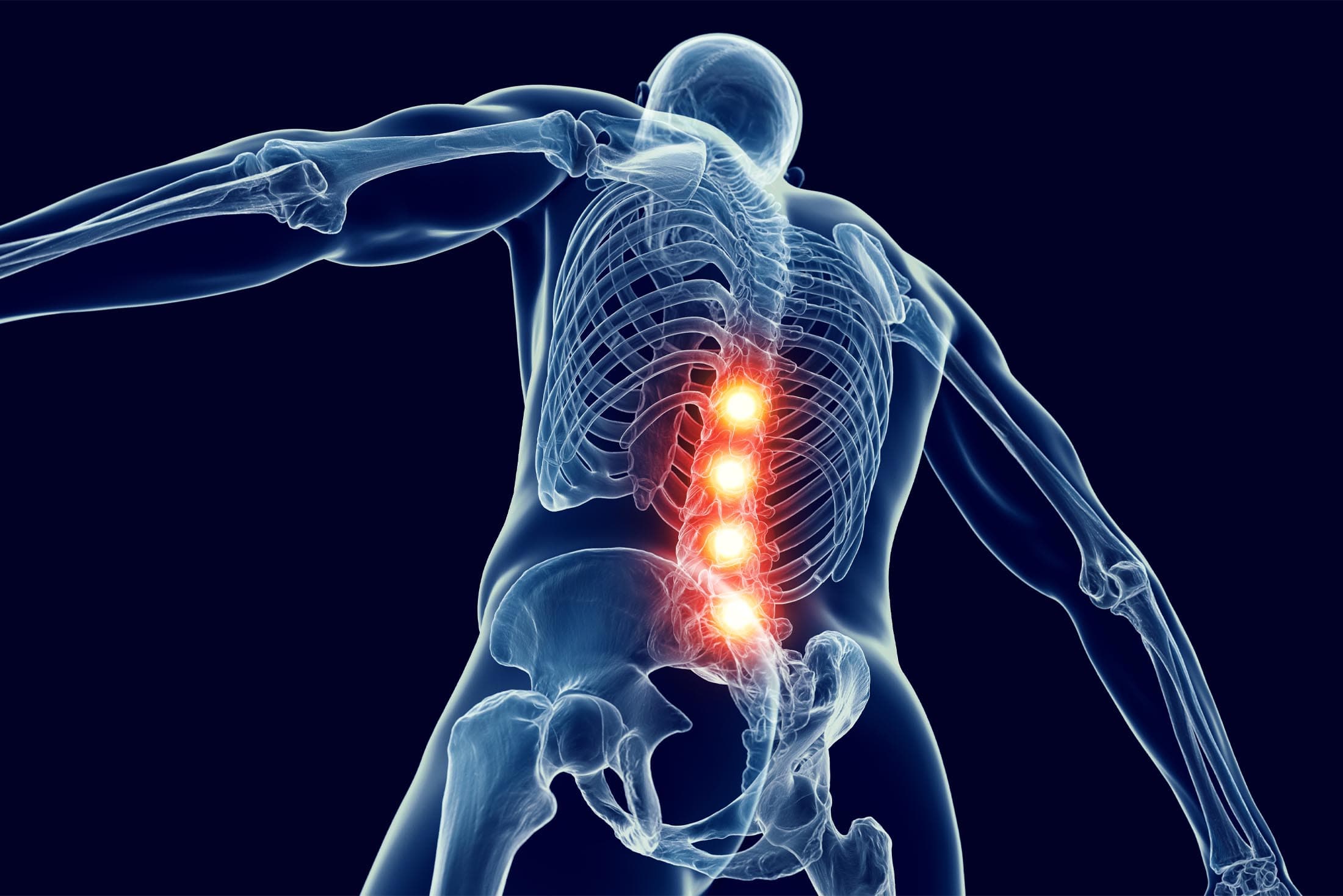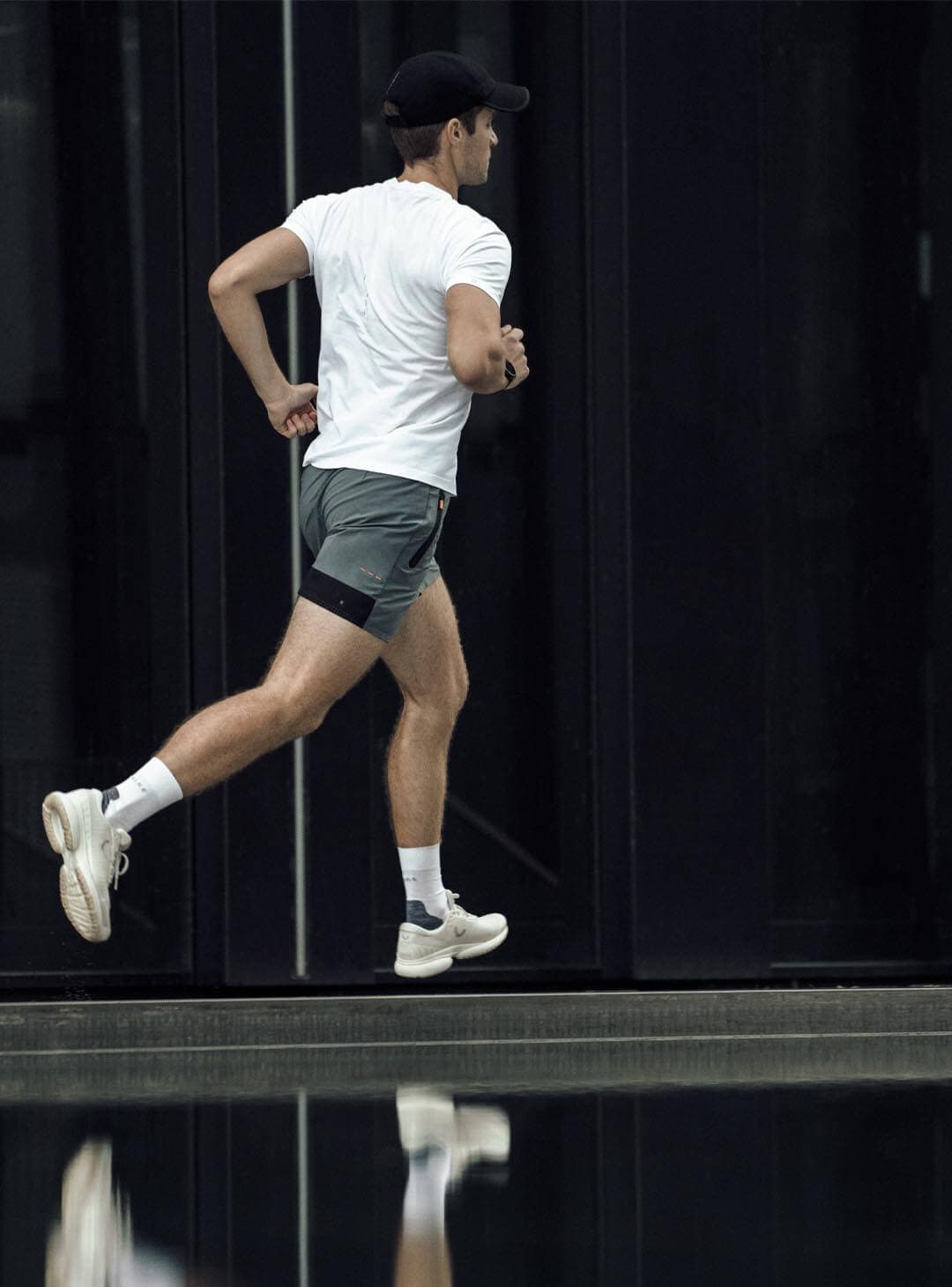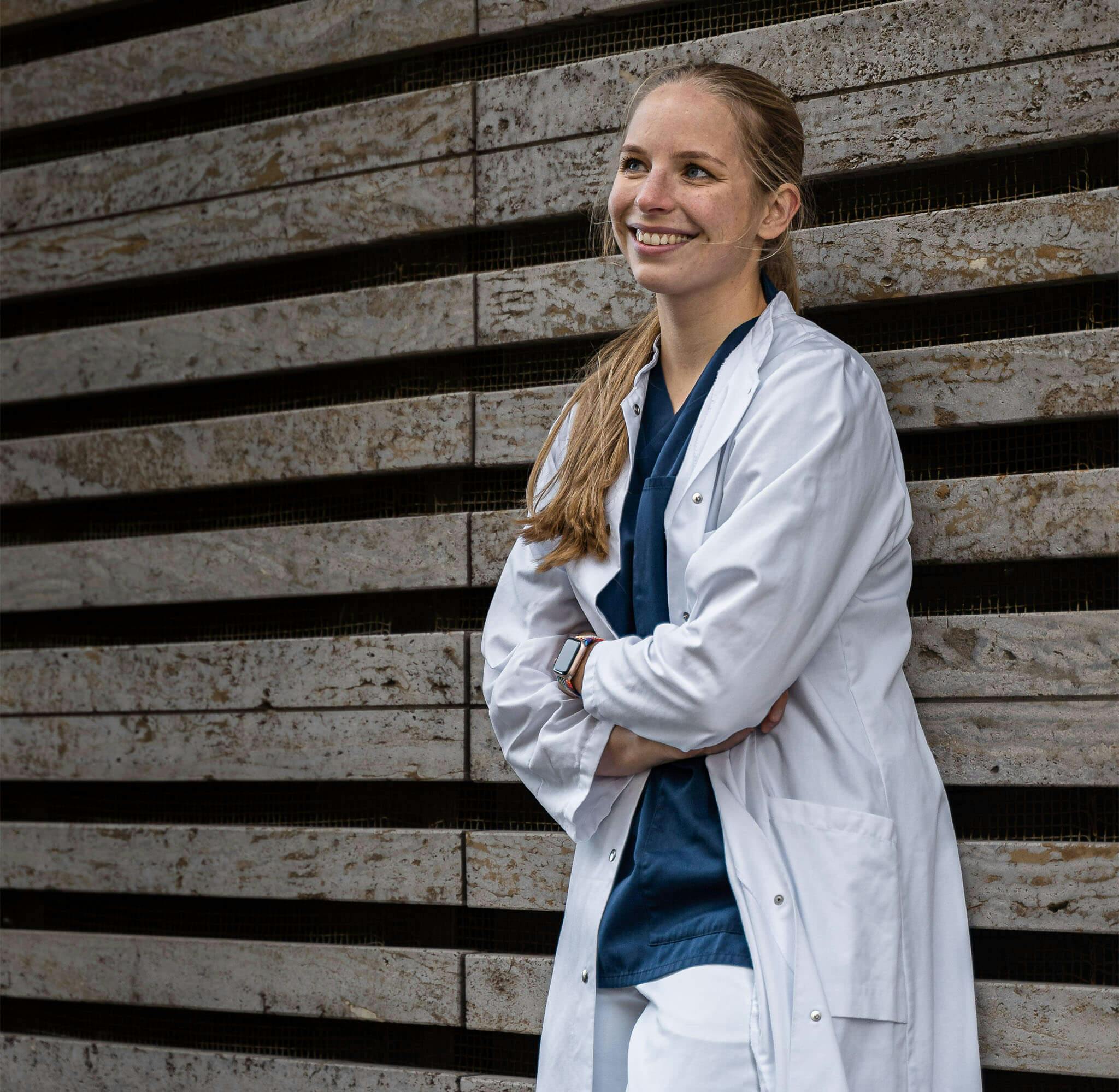
Photo: Dr. Säugling
OUR BACK IS A NATURAL SHOCK ABSORBER:
WHY WE HURT OUR BACKS WHEN WE RUN
With every step, forces act on our body – every single time. Again and again. To absorb these forces and make them non-harmful to our structures, our body has various shock-absorbing mechanisms. One of the most important ones is our back. However, if it is subjected to excessive or misdirected loads, it is a matter of time before pain makes it difficult for us to run – or even prevents us from running altogether. And that’s exactly what happens far too often; more than one in eight runners suffer a back injury at least once a year. Dr. Matthias Säugling, orthopedist, sports physician, and team doctor for the German Ice Hockey League team Kölner Haie, gives an insight into how the back works and explains why the lower back is particularly susceptible to injury in runners.
Our back is a complex construct of vertebrae, intervertebral discs, muscles, and tendons – and forms the center of our body. 24 free vertebrae in the area of the cervical, thoracic, and lumbar spine are connected by 23 elastic intervertebral discs. Another five vertebrae, grown together, form the sacrum, before the lowest four vertebrae converge in the coccyx.
Thus, there are many individual components that have to work together to enable us to move about without pain – which is exactly what we normally do. However, overloads can cause injuries when we run. These are so-called overuse injuries. After the knee and the Achilles tendon, the back is the third most frequently injured structure in runners. In figures: 12.47% of all runners injure their backs at least once within a year so severely that they have to take a break from running. This is shown by the results of the Run Better Research Study with 1,700 participants, which proves a connection between injury frequency and running shoes. (All results of the Run Better Research Study can be found in Chapter 5, Part 2).
But why is the back particularly exposed to stress during running? A look at the structure, function, and position of the back in the human body provides some insight.
CONTINUOUS COMPRESSION OF THE BACK DURING RUNNING
In running, we speak of a cyclical sequence of movements. This means that one and the same partial movement takes place in succession, without a recognizable beginning and end. In running, as in walking, a movement sequence represents the combination of two successive steps, one with the right foot and one with the left foot. After that, the same sequence of movements is repeated in a continuous loop – until we interrupt it, for example, to stop.
This sequence of movements therefore consists of so-called cyclical movements. Here, the same loads act on our body again and again – and thus also on our back. It is compressed with every step. A recurring pressure weighs on the spine. “The back acts as a natural shock absorber due to its structure consisting of the sequence bone – intervertebral disc – bone – in addition to the pelvic muscles, the Achilles tendon, and other structures. It absorbs the forces that occur as soon as we move,” explains Dr. Matthias Säugling, specialist in orthopedics, trauma surgery, and sports medicine at the MediaPark Orthopedics Center and team physician for the Kölner Haie ice hockey club.

Illustration: Adobe Stock
What sounds brutal at first is actually not that dramatic. After all, the back is designed to absorb precisely these forces. “Nevertheless, the recurring strain of running can lead to back problems, such as herniated discs or signs of wear and tear, being aggravated – especially if the muscles are not properly stabilized,” the expert explains.
Such muscle imbalances or the smallest misalignments aof individual structures can cause back pain or even serious injuries to develop. It should always be taken into account that everyone suffers signs of wear and tear on their structures in the course of their lives – some more, others less. Nevertheless, we should try not to accelerate this process through misdirected loads.
Now, when it comes to identifying the cause of painful running conditions, it is important to look at the entire body when diagnosing injuries. Nevertheless, special attention should be paid to the back compared to other structures of the body. “In most cases, pain radiates from the back into adjacent structures; only in a few cases is it the other way around,” Dr. Säugling says. Thus, in the majority of cases of back pain among runners, it can be assumed that the injury is also to be localized in the back, he says. In most cases in the area of the lumbar spine, i. e., the lower back.
INJURIES PARTICULARLY IN THE LOWER BACK
“When running, particularly large loads act on the lower area of the spine – this is where we get injured most often when running,” says the Cologne-based sports physician. One of the injuries that become noticeable through pain in this area is an inflammation of the facet joints – caused by incorrect and excessive loads on the spine that lead to harmful pressure distributions.
The facet or vertebral joints are the joints that connect the articular processes of two vertebral bodies of the spine. The sports medicine specialist explains, “If the pressure acting on our backs during running is too great – for example, due to muscle imbalances – the facet joints of our spine can become inflamed. Lower back pain develops.”
Basically, back injuries in runners are divided into two different types of injuries; those that occur as a direct result of incorrect loads from running, and those that are pre-existing and can be aggravated by the loads of running.
“A herniated disc, for example, is not a classic running injury,” explains Dr. Säugling. “Nevertheless, it can be promoted by an unsuitable running style and incorrect loads in the back. Back conditions such as the so-called slipped vertebrae, osteochondrosis or facet arthrosis can also become worse by running and are complaints that are common among runners.”
Slipped vertebrae are unstable vertebral bodies that shift from their normal position and constantly slide forward or backward. This phenomenon often occurs in the lumbar spine. Osteochondrosis, on the other hand, is a wear-related change in the intervertebral disc and adjacent bones. As part of a continuous overload, the intervertebral discs in the spine are compressed and unable to regenerate over time.

Illustration: Adobe Stock
The severely worn disc eventually leads to an instability of the mobile segment. Doctors call facet arthrosis a degenerative, wear-related change of the facet joints, which can result from a persistent inflammation of these very joints.
But why do we get injured while running in the first place?
For the orthopedist, there is no single reason why so many runners hurt their backs. “In most cases, injuries develop from a variety of smaller factors. Many runners want too much too fast. Especially after long periods of inactivity, many novice runners initially overdo it.”
And that’s exactly a problem. Because the structures of the human body first have to get used to the strain. If we are too impatient and put too much stress on our bodies, we risk injuries. This is true for our backs – but also for every other structure in our body.
In addition, the choice of running shoes also plays a role in minimizing the risk of running injuries – to the back as well as to the knee, Achilles tendon, or other regions.
THE RIGHT RUNNING SHOES ARE IMPORTANT TO RELIEVE STRAIN ON THE BACK
To get a meaningful picture of the degree of their patients’ injuries, Dr. Säugling and his colleagues at Orthopädie MediaPark like to use a movement and running analysis at the Institute for Functional Diagnostics, or IFD Cologne. “With the help of a running analysis, the overall movement during running can be broken down in an ideal way. Imbalances, incorrect loads, and weak points can be reliably uncovered,” explains the orthopedist.
Once the problem has been identified, it is then a matter of taking targeted countermeasures. Movement patterns can be corrected or weakened structures can be carefully retrained. The goal is to alleviate symptoms and stabilize the structures involved.
This is precisely why Dr. Säugling always takes a look at the running shoes the patients wear. “Running shoes are an important factor when it comes to running without discomfort. Thus, a running analysis always includes an analysis of the footwear and a subsequent individual consultation with the patients as to which running shoes are best suited for them personally.”
BE IN YOUR ELEMENT!
U-TECH NEVOS ELEMENTS NEXT GEN
By night. And by day. When the world hushes to a whisper and we feel the thrill of endless possibilities. When we start at our front door, running through streets and woods. When summer blend into fall, when we run through water and jump above sticks and stones, when exploring new ways. No matter what. Then we run wherever and whenever we want. Meet the new U-TECH Nevos Elements next gen.
In a comparison of midsole technologies, biomechanical running shoes with U-TECH™ reduce the risk of developing running injuries – as shown by the results of the Run Better Research Study. (For all results of the large-scale study, see Chapter 5, Part 2.)
True Motion’s U-TECH™ technology harnesses the natural functions of the foot. Inspired in form and function by the round and elastic menisci in the knee and the fat pad, all True Motion running shoes feature a U-shaped midsole in the rearfoot. This way, the heel sinks into the sole construction when we touch down, and the forces that occur are centered and passed harmlessly through our joints. The load on our body decreases – and the risk of back injuries while running is reduced.
Following the motion analysis, including a running shoe analysis, the patients receive individually tailored physiotherapy for days and weeks to enable them to run again without pain or discomfort. “The first step is, of course, to alleviate the patients’ acute symptoms,” says Dr. Säugling. “But it is at least as important to clarify why a runner gets injured. In addition to symptom management, it’s critical to identify the cause of the pain. That’s the only way we can prevent recurring discomfort in the long term.”
Wrestler Roland Schwarz had to experience first-hand how much a hurting back can limit us. The World Championship bronze medalist in Greco-Roman style had to have disc surgery due to persistent pain. He needed patience on his way back to the sport. And new ways. Roland Schwarz tells us what role running plays in his everyday training routine in Chapter 9 (Part 2) of our Run Better Project.
RESEARCH AND DEVELOPMENT:
SCIENTIFICALLY VALIDATED TECHNOLOGIES
Almost 100 % of our technology is derived from scientific findings and biomechanical research. Prof. Dr. Gert-Peter Brüggemann, head of the Institute for Biomechanics and Orthopedics at the German Sports University Cologne for decades, is largely responsible for this. Over the past 25 years, he has been part of numerous innovative running shoe developments – and thus a sought-after expert among the giants of the industry.




NEVER RUN OUT OF
NEWS
Discover all True Motion stories – and be the first to hear about new products, promotions and events. Simply, center your run!

NEVER RUN OUT OF
NEWS
Discover all True Motion stories – and be the first to hear about new products, promotions and events. Simply, center your run!
RECOMMENDED BY








RECOMMENDED BY








GET 10 % OFF YOUR FIRST ORDER!
Get your personal running updates with exclusive discounts, product news, training plans and tips for healthy running - straight to your inbox. 10% discount on your next order.
SERVICE
ABOUT US
© 2025 True Motion Running GmbH










